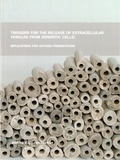Triggers for the release of extracellular vesicles from dendritic cells
Implications for antigen presentation

Lindenbergh, Marthe
- Promoter:
- Prof.dr. W. (Willem) Stoorvogel
- Co-promoter:
- Dr. M.L. (Marianne) Boes
- Research group:
- Boes , Stoorvogel
- Date:
- November 19, 2019
- Time:
- 12:45 h
Summary
Our health relies on an effective immune system. Although many mechanistic elements of adaptive immunity have been resolved during the last decades, our knowledge of its complexity is still incomplete. For example, we do not fully understand how foreign antigens are discriminated from “self” in adaptive immune responses. This leaves challenges for the design of more effective and safe vaccines. Previously, it has been demonstrated that dendritic cell (DC)-derived extracellular vesicles (EVs) carry peptide-loaded MHC class I and class II complexes with the capacity to activate naive T-cells. However, the exact triggers and mechanisms underlying the release of these EVs as well as the significance of their contribution in activating the adaptive immune system at physiological conditions remains incompletely defined. In this thesis, we explored the potential role of DC-derived EVs in this context. We identified different triggers that induce the release of EVs by DCs, and explored their potential for antigen presentation. Firstly, we found that bystander T-cells induce the release of antigen presenting extracellular vesicles by DCs. Strikingly, the activation status of the bystander T-cells directed the release and composition of the antigen-presenting EVs, which we found to be able to activate antigen-specific T-cells. We propose that antigen presenting EVs that are released by DCs in lymph nodes in response to contact with bystander T-cells may help to disseminate antigen presenting capacity, resulting in activation of a larger number of T-cells. Next, we investigated the influence of phagocytosis on the release of DC-derived EVs. We observed that DCs expulse significant amounts of previously phagocytosed bacteria back into the extracellular environment, and concomitantly release antigen-presenting EVs. Our data support the idea that the EVs can be generated as intraluminal vesicles in pathogen containing phagosomes, and that MHC molecules present in these EVs may be selectively loaded with antigens that derive from the phagocytosed pathogen. Lastly, we explored the how in ankylosing spondylitis, dysfunction of SPPL2a provokes the immune system to produce autoantibodies to CD74, an intracellular chaperone molecule of MHC class II. Although we did not analyze the role of antigen-presenting EVs in this context, we found that dysfunctional SPPL2a affected proper endosomal processing of CD74, and consider it is very well possible that endosome-derived EVs also play a role in this process. Based on these results, we hypothesize that release of EVs by DCs is carefully orchestrated by different triggers, and that the nature of these triggers determines the capacity of the EVs to present antigens. Better understanding of these triggers helps us to understand and can aid us to tune our adaptive immune system towards more effective immune responses.